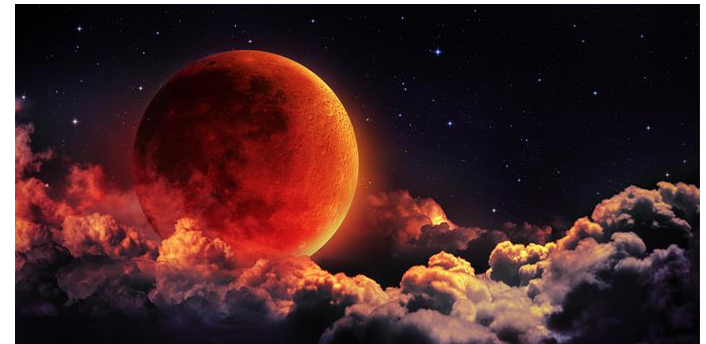
Blood Moons, the Lunar Eclipse and the 15th of Av
Question
This Friday is Tu B’Av, said to be the happiest day on the Jewish calendar. Oddly enough, I read that on that night, not only will there be a lunar eclipse, but in some parts of the world (mainly Africa, Asia and the Middle East) stargazers will see the longest total lunar eclipse of the 21st century, also known as a “blood moon.”
Does that have any significance? Is this something to worry about? I have seen some religious groups claim that this is a sign of terrible calamities to come.
Reply
In describing future events, the prophet Joel foretells that “[G?d] will set wonders in the heavens and the earth: blood and fire and pillars of smoke; the sun will turn to darkness and the moon to blood before the coming of the great and awesome Day of G?d.1”
There is much discussion in the commentaries about the meaning of this prophecy. Many explain it to be allegorical. However, the biblical commentator Rabbi David Kimchi (known as the RaDaK, 1160–1235) explains that when there is a total eclipse, the moon appears dark; however, when it is only partially covered, it appears red like blood, symbolizing the fall of the wicked.2
A blood moon is indeed an omen, but an omen of the downfall of the wicked.In other words, yes, according to some, a blood moon is indeed an omen, but an omen of the downfall of the wicked.
A Full Moon
As you wrote, this eclipse will take place on Tu B’Av, the 15th day of the month of Av. It is interesting to note that a lunar eclipse or a “blood moon” can by definition only occur on the 15th day of a Jewish month, i.e. when there is a full moon.
Ordinarily, the Talmud tells us that a lunar eclipse is considered a bad sign for the Jews, since we calculate the months according to the lunar cycle.3 However, a full moon is considered to be a positive sign for the very same reason.4
In the end, we are reminded of the words of our sages that “when Jews perform the will of G?d, they need not worry about omens or celestial phenomenon. Thus says the L?rd, ‘Do not be frightened by the signs of the heavens.’”5
The Full Moon and the 15th of Av
The Lubavitcher Rebbe points out6 an interesting connection between the moon and the 15th of Av. On the one hand, the mystics explain that the underlying significance of the day is that it is the first full moon after the saddest day on the Jewish calendar, the 9th of Av, which marks the destruction of the Holy Temple. Thus, since we calculate the months according to the lunar cycle, and since the Jewish nation is compared to the moon, we celebrate this significant day.
And yet, if one thinks about it, the 15th day of the month actually marks the time when the moon starts waning. If we were to take a lesson from the moon at the beginning of the month, it would be to always add in light—but what lesson can we learn from the moon on the 15th of the month, when it starts decreasing?
To answer this, we must note that there is a difference between the incompleteness of the moon during the time it waxes and the time it wanes. In the first half of the month when the moon waxes, its incompleteness is a sign that something is still missing in our work to bring light both to ourselves and to the world around us. Once we reach the middle of the month, the full moon is a sign that we’ve reached our full brightness, both in our own service to G?d as well as in bringing light to the world.
There is a catch, however. The bigger and brighter a person gets, the more the ego begins to flourish. The bigger and brighter a person gets, the more the ego begins to flourish. We know that true spirituality can only rest in those who are humble of spirit. Thus, once we have reached the middle of the month, it is now time to work on the ego. We don’t, heaven forbid, diminish our efforts to make the world a brighter place, but we do work to diminish our feelings of spiritual superiority and self-importance. It is this humility that is symbolized by the waning of the moon in the second half of the month.
This correlates with the Talmud’s statement that from the 15th of Av and on, the nights start getting longer, and it is an opportune time to increase in one’s learning of Torah at nighttime. This can be understood metaphorically as well: increase in one’s feeling of humility while learning Torah, for it is only through humility that one can really reach the essence of the Torah.
FOOTNOTES
- Joel 3:3.
- Radak on Joel 3:3.
- Talmud, Succah 29a.
- Pri Etz Chaim, Shaar Chag Hashevuot—Derush L’Chamisha Asar B’Av.
- Talmud, Succah 29a.
- See Likutei Sichot vol. 34 pp. 48-50
Source: Chabad.org